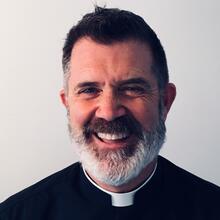Last weekend, Catholics in western Montana did something new: We celebrated Masses together in a church. We were not in our homes alone, not looking at a small screen, not unshaven and wearing pajamas late into a Sunday afternoon but with each other in a church building. Some of us wore masks; others did not, either intentionally or having forgotten the mask at home. Everyone sat apart and prayed together for a hundred thousand strangers.
Montana—with under 500 cases and fewer than 20 deaths from Covid-19—is a vastly different reality than many other regions in the country. For those hard-hit communities, maybe we can be an image of what the future might hold. Of course, any re-opening of worship spaces must be cautiously phased in as safety restrictions are implemented. But this weekend, here in Missoula, the church was filled with promise, if not yet with parishioners. We see the green shoots of a new church beginning in every other pew, behind creatively decorated masks and warmly expressed in elbow bumping. After two and half months out of the building but still very much a church, it was a start.
Last weekend, Catholics in western Montana did something new: We celebrated Masses together in a church.
I hope it was the delicate birth of something new rather than a patched up facsimile of pre-pandemic worship. To be honest, did the old “normal” way of doing things exhaust all possibilities for communal celebration? Is that what we want to return to, even if doing so were possible? In our first weekend of physical gathering, there were signs everywhere of an old church doing something new. And I imagine not just in Montana but all over the country Catholics are again reimagining what it means to worship together—and what it could be.
As the presider at our first four weekend Masses, it was a joyous, somber, confusing experience. There was clapping and some cheering at the beginning of Mass, and that was exciting. We provided lots of health and safety guidelines as we followed the bishop’s directives; that was less exciting. The musicians could not invite people to sing along, the ushers worked at being clearly heard behind a mask, and the priests just tried to keep up.
Ten weeks is a long time to be away from each other, and we are now a different people in a different time. We were apart for three weeks of Lent, Holy Week, Easter Sunday and then most of the Easter season. Those were eventful weeks in the liturgical calendar that, this year, we lived in a whole different way.
In our first weekend of physical gathering, there were signs everywhere of an old church doing something new.
But the time apart was not time wasted. It took a pandemic, but we are discovering ways to move our community online—or more precisely, to discover our community already online. Like many parishes, we knew we were missing the move into the digital space, and we are lucky to have deeply committed staff ready to move us there. Who knew that a smartphone was to become our best friend inside a church? With it as our camera, week by week, we got better at livestreaming Mass from the sanctuary and from the living room of the Jesuit community. We loved both settings. Viewers appreciated the close-ups of the altar, the chance to post petitions during the Mass and to pray at a distance with each other. And this way of being community is not going away, once in-person worship is again possible. We now have more ways to connect, and we intend to keep using them. That livestream is here to stay.
In western Montana, at the moment, we no longer exchange a sign of peace, and yet we still want peace for each other. And we no longer share a common cup, and yet we still receive Christ together. We now sit farther apart and might be wearing a mask, and the Communion procession is awkward, but we are still choosing to be together as much as the times permit. Our worship will get fuller as together we learn new steps in a new time.
But some things do not change, and I love that, too. At the family Mass, I preached over the full-throated crying of a child for the first time in weeks. I thought: This is what I miss, the presence of the rest of the church; small and large, silent and shouting. Ten weeks of being at a distance, preaching without interruption, to an empty church, to a smartphone camera, and I was glad to hear that kid crying, so glad to worship together as we discover new ways for an old church.










